Basics of Ship Construction
The initial stages of construction revolve around fabricating, piece by piece, the structure of the vessel. The panels are created and shaped into blocks which are chunks of the ship’s structure that can weigh dozens of tons. The blocks are then blasted ,painted then processed in the final stages of outfitting where equipment, cables and piping are installed .At times the blocks are turned upside down as the work is easier to perform facing the ground. Once assembled the pieces of blocks are consolidated into larger blocks and finally the form of a ship emerges. The vessel is launched into the water where the final finishing takes place alongwith installation of any remaining equipment and the vessel’s systems undergo a final check. Thereafter the vessel is considered seaworthy to carry cargo.
LNG Vessels Costly
While Oil tankers, bulk carriers and container ships comprise almost 85 % of total capacity one needs to appreciate the varying costs of construction. A prime example of cost variability is evident as Hanwha Ocean Co., being the world’s third largest shipbuilder has been awarded an order worth US $ 1.8 billion to build eight liquefied natural gas (LNG) ships for QatarEnergy at its shipyard located at Geoje Island around 330 km south of Seoul. Each LNG ship will be constructed at a cost of US $ 225 million and the 8 LNG vessels are expected to be completed in 4 years. Generally LNG ships are the most expensive vessels to construct.
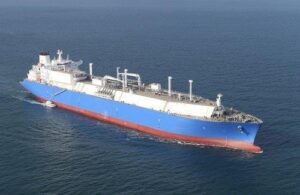 Credit : YONHAP NEWS AGENCY
Credit : YONHAP NEWS AGENCY
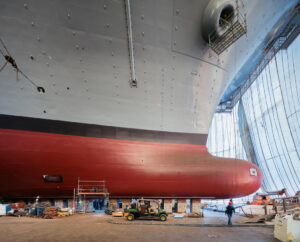 Credit : New York Times
Credit : New York Times
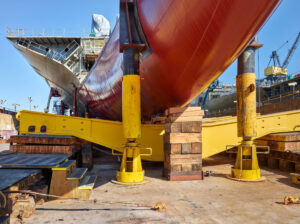 Credit : New York Times
Credit : New York Times
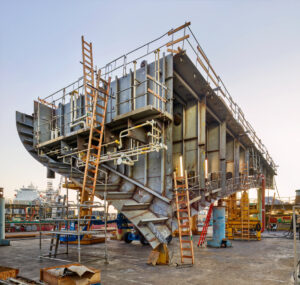 Credit New York Times-Merlin
Credit New York Times-Merlin
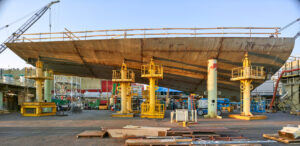 Credit : New York Times
Credit : New York Times
China’s Merchant Navy & Military Ship Building Spree
China’s immediate agenda seems to be to secure control of its littoral areas and the seas nearby .The fact of the matter is that the smaller U.S. Navy needs to maintain a global presence from the North Atlantic to the Mediterranean Sea to the Persian Gulf to the Western Pacific. Three years back China had managed to acquire ownership in at least 30 of the 50 largest container ports in the world and during the pandemic associated era when lesser developing maritime countries were reeling from economic challenges it gained footholds in some of the hardest hit economies like Panama, whose economy shrunk by about 18 % in the year 2020. Facts are that the U.S. is the primary user and beneficiary of the Panama Canal as almost 60% of goods transiting the canal are destined for U.S. ports.Concerns arose in US policy making circles that increased Chinese dominance over port infrastructure surrounding the Panama canal could ,in times of conflict, pose a threat to the US logistic supply chain. As evident China has its proverbial economic and commercial aspect to grind which was manifested when China inked a memorandum of agreement with the Panama Canal Authority in 2017 and Panama ceased its diplomatic recognition of Taiwan much to the chagrin of the United States of America. Contemporary trade patterns and military or naval patterns are mutually reinforcing highlighting an ongoing reduction of U.S. maritime influence. To address this loss of US military and naval dominance the political culture will need to be recasted. About 11 billion tons of goods are annually transported through oceanic trade and the US trade has a sizeable component of global trade.The decline of U.S. shipbuilding is a reflection of its broader deindustrialization . What industrialised goods does the US produce. As of today one full service shipyard exists on the entire West Coast of the US and leaving aside submarines every segment of the domestic shipbuilding industry, both military and commercial, is facing an uncertain future. The Trump administration’s last industrial base report to the US Congress aptly summed up that the largest contributing factor of declining U.S. competitiveness in global shipbuilding has been state subsidised intervention from competitor countries especially from China leaving the US shipbuilding industry in a lurch.
 Credit : UNCTAD
Credit : UNCTAD
Worldwide consolidation is witnessed as the number of shipyards dropped steadily from about 700 in the year 2007 to about 300 by 2022. A contraction has occurred worldwide in shipbuilding capacity contract . Annually between 1,200 to 1,300 vessels can be constructed compared with the earlier years annual capacity of construction of 2,000 vessels during the period 2005 to 2010, increased tonnage of ships notwithstanding . Due to the significant consolidation that took place amongst shipbuilders in the intervening years almost 75% of world shipbuilding capacity is entrenched amongst 9 shipbuilding groups. Going further 68%, 92% and 71% of the capacity in China, Korea and Japan respectively, is exclusively handled by 3 shipbuilding groups. In other words 50 % of the world’s tonnage is owned by Asian companies , 38 % is European and Northern America accounts for a minor 5 %. These statistics are alarming for the US maritime sector which once held sway over ship construction.
 Credit:NASSCO
Credit:NASSCO
The major US owned shipyard NASSCO located near the port of San Diego continues to build commercial and military ships.A typical commercial ship takes NASSCO about 3 years to complete including roughly 12 to 16 months of detailed design and planning. It is to be seen if the maritime sector in USA can generate sufficient political clamour to convince policy makers and legislators that China is making inroads into traditional US commercial ,trade, naval and military domain. The US sphere of influence is coming under increased challenge by Asian countries especially China and the US commercial maritime sector has to redefine its global role if it wants to continue to be recognised as a global ocean going power.
Authored by Razeen Ahmed , Reviewer Nadir Mumtaz
https://en.yna.co.kr/view/AEN20240325008100320
https://www.nytimes.com/interactive/2020/06/17/business/economy/h ow-container-ships-are-built.html
https://splash247.com/shipbuilders-struggle-to-get-out-of-the-red- despite-multi-billion-dollar-orders/

Leave A Comment